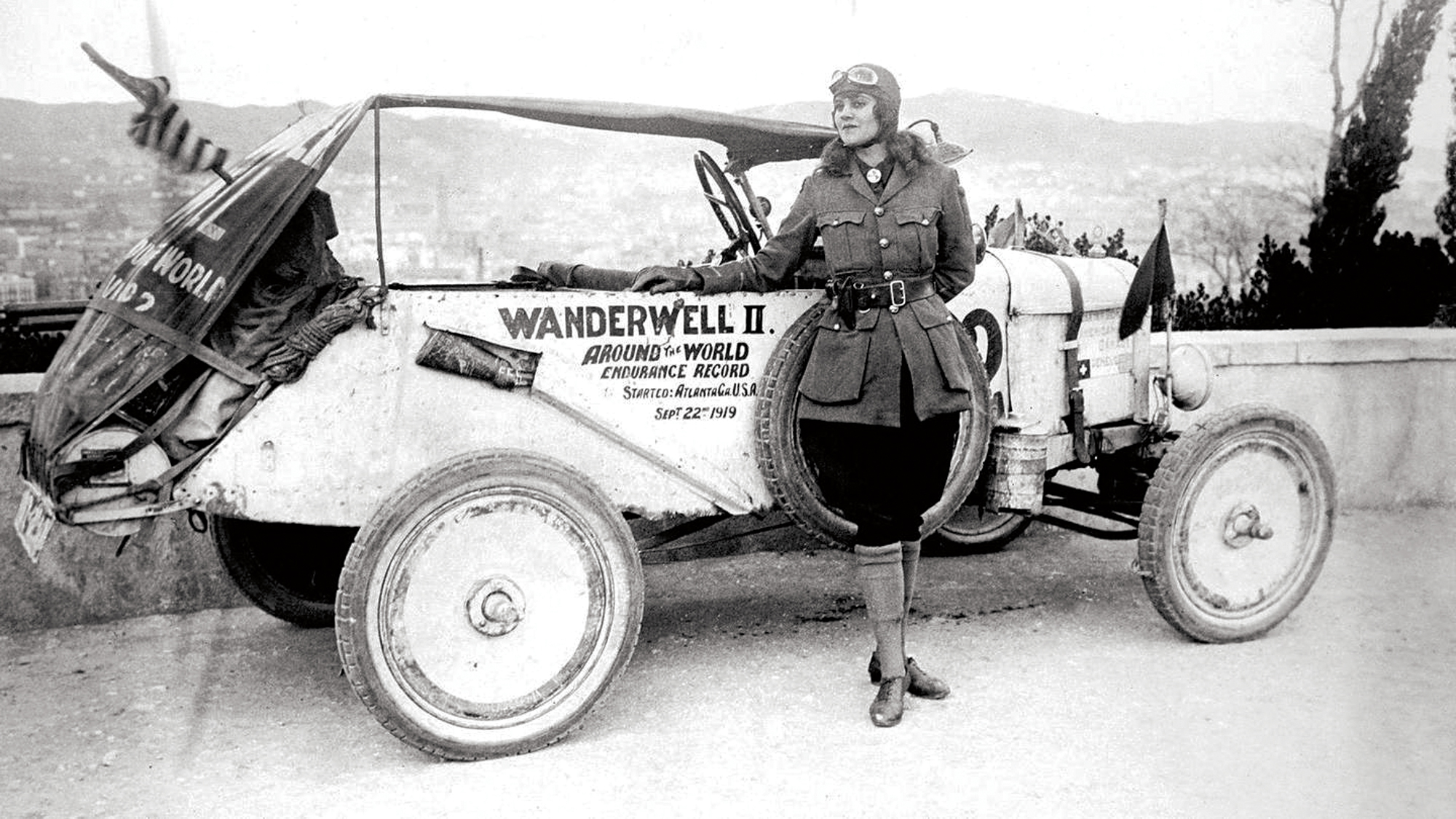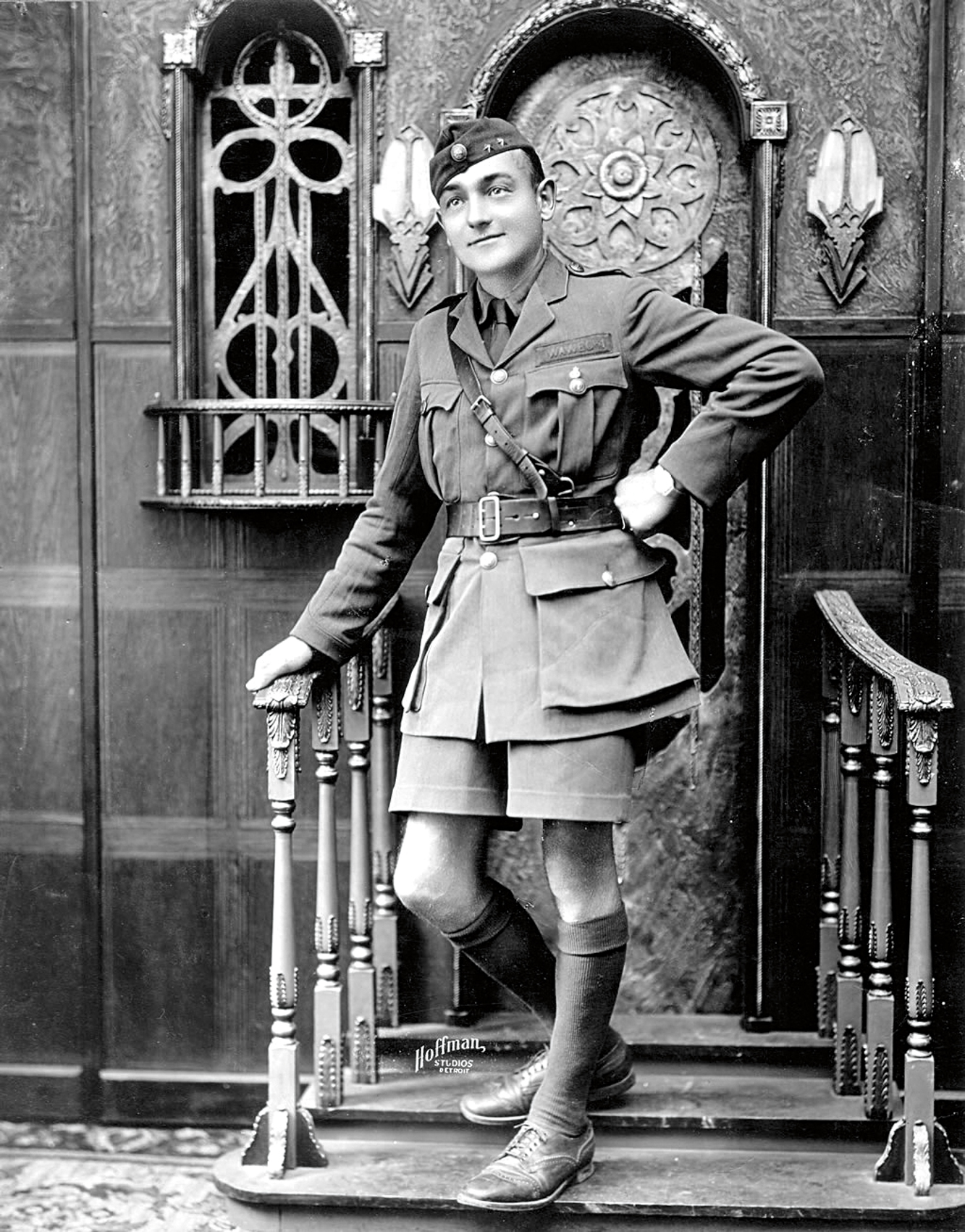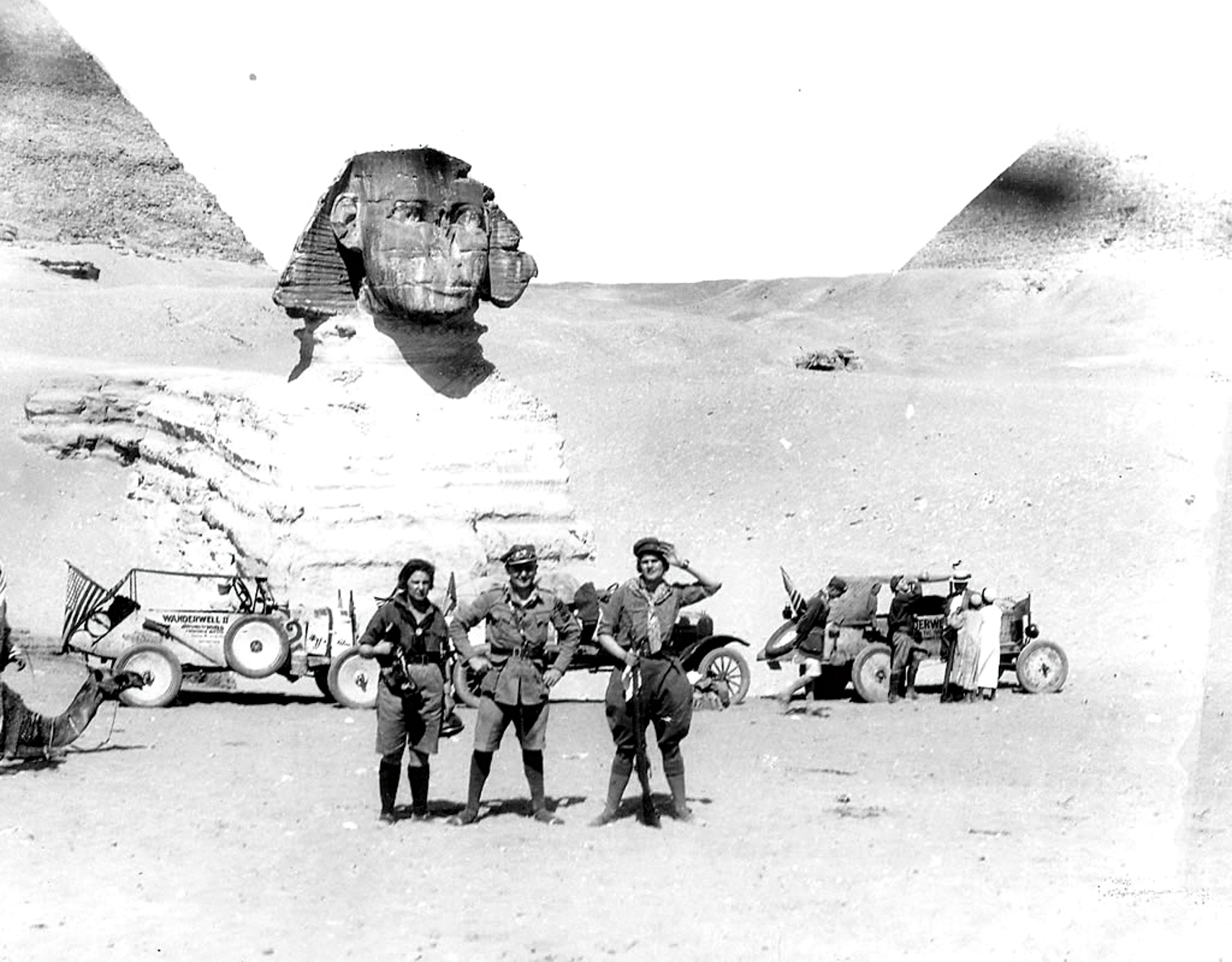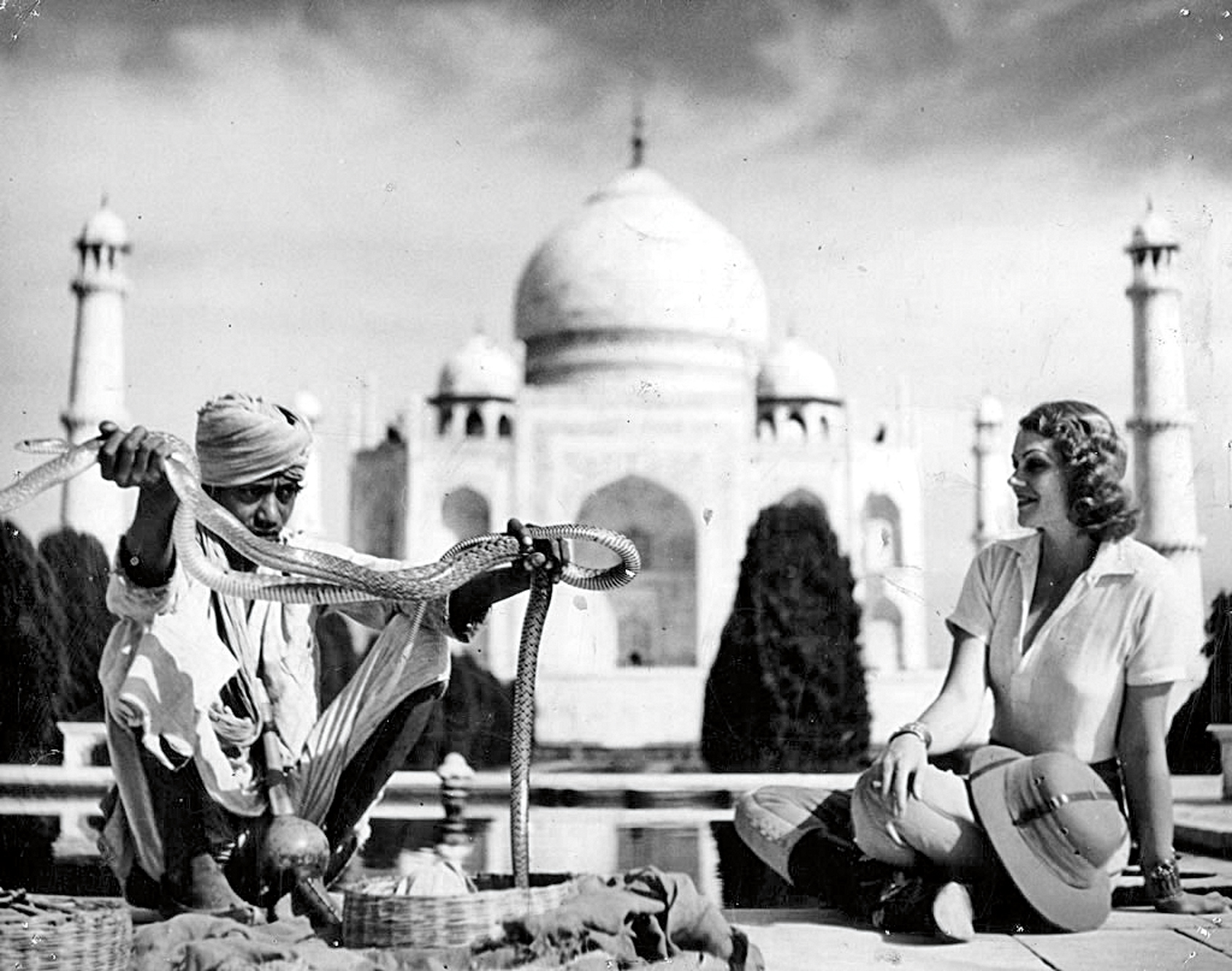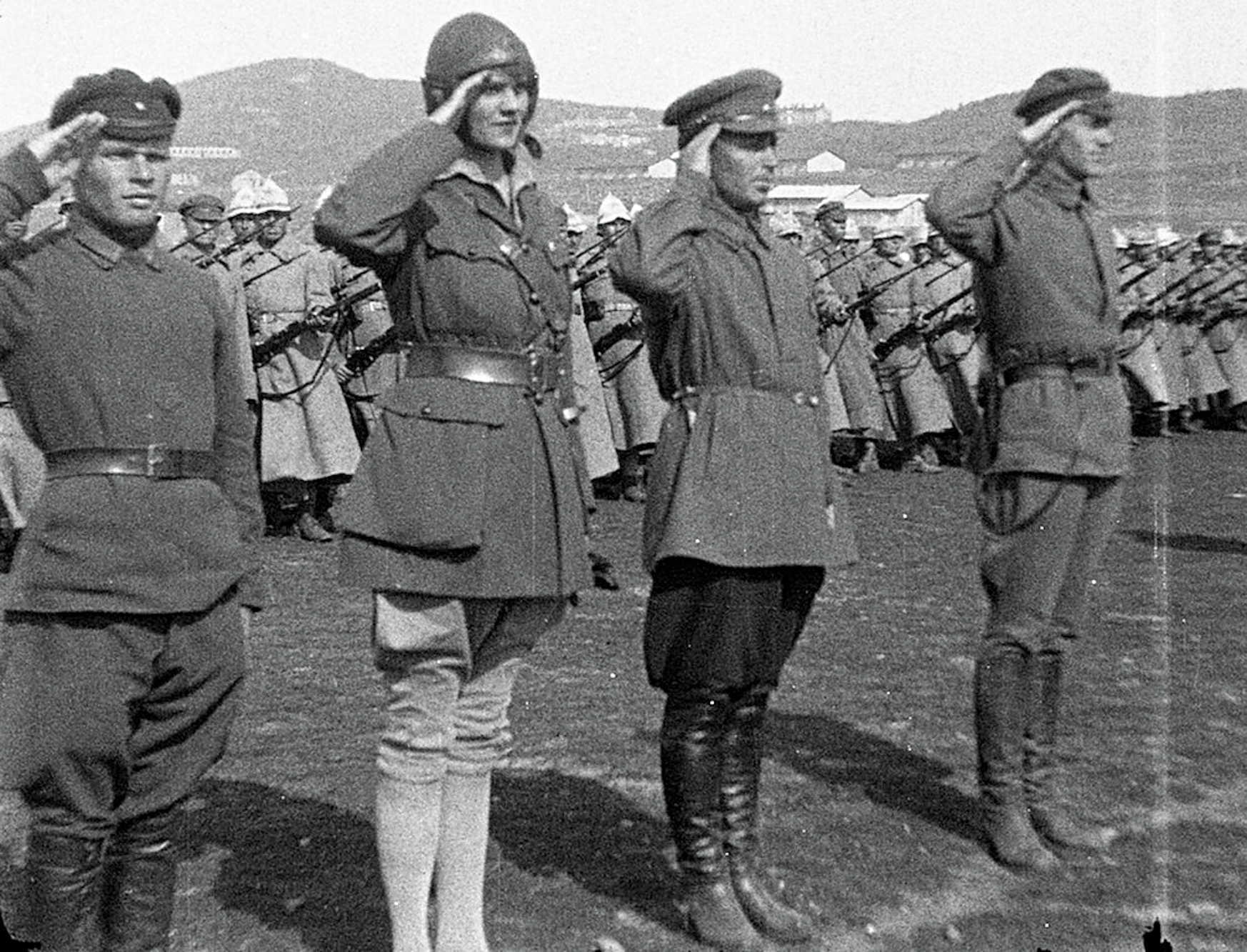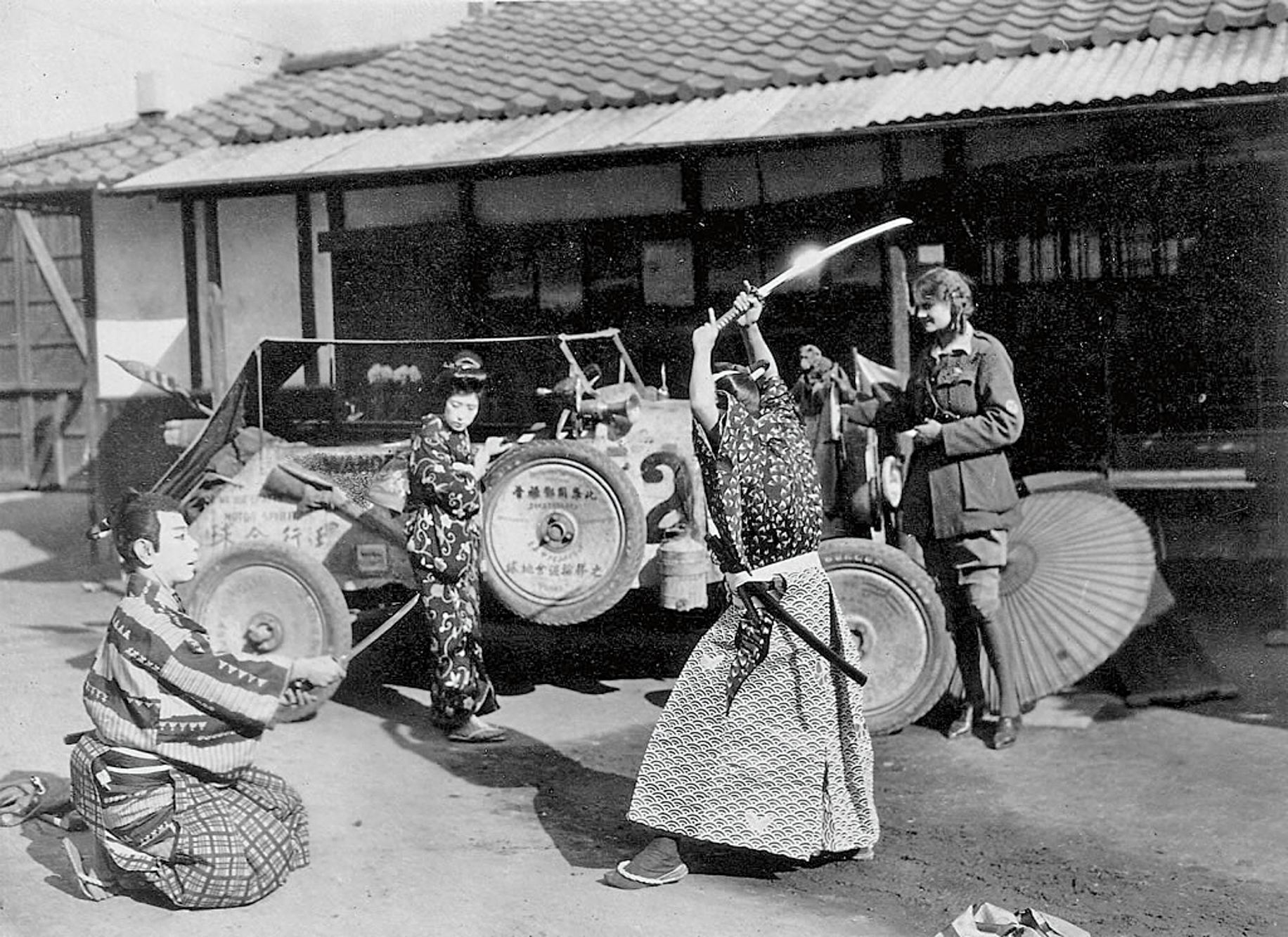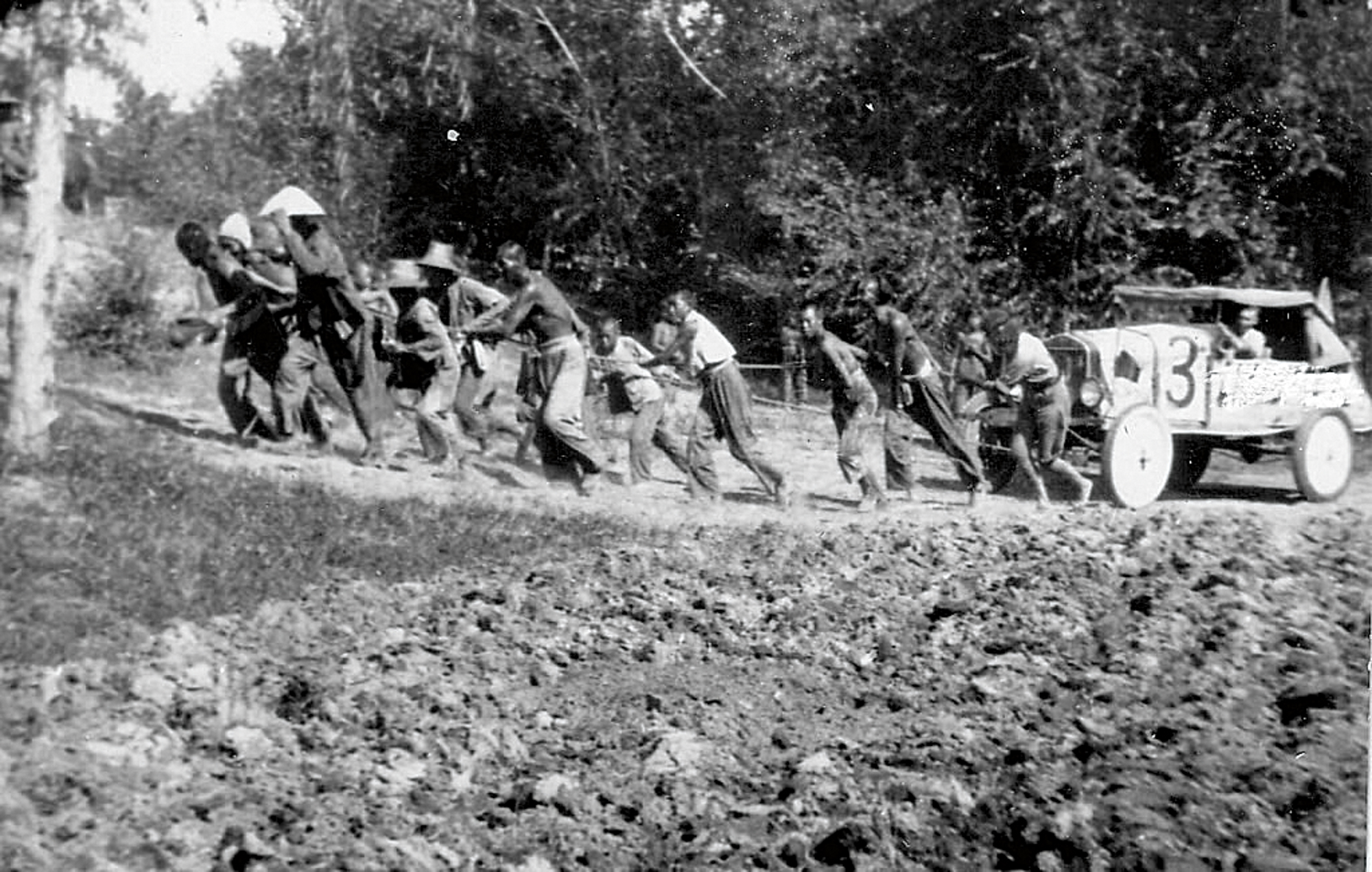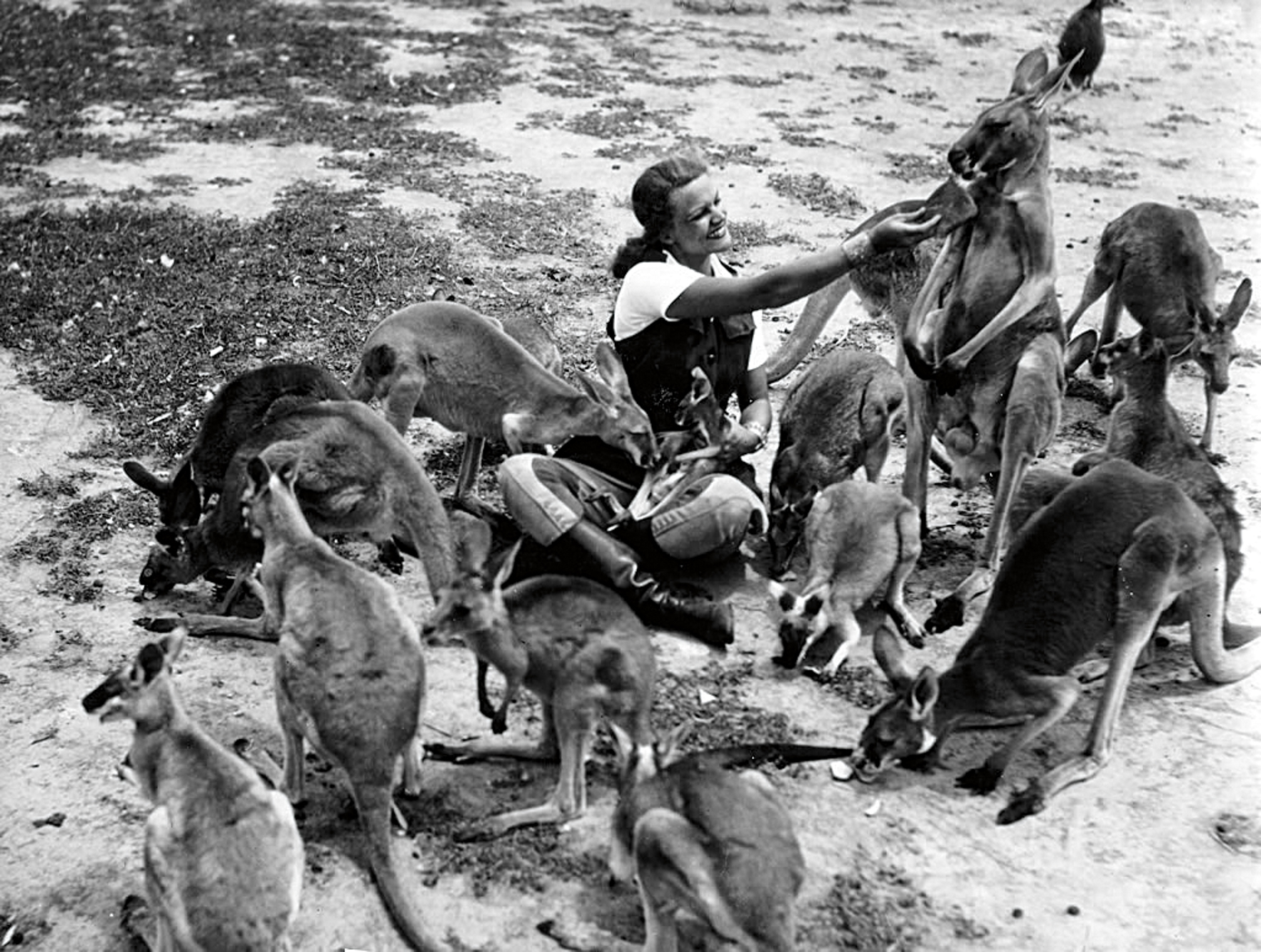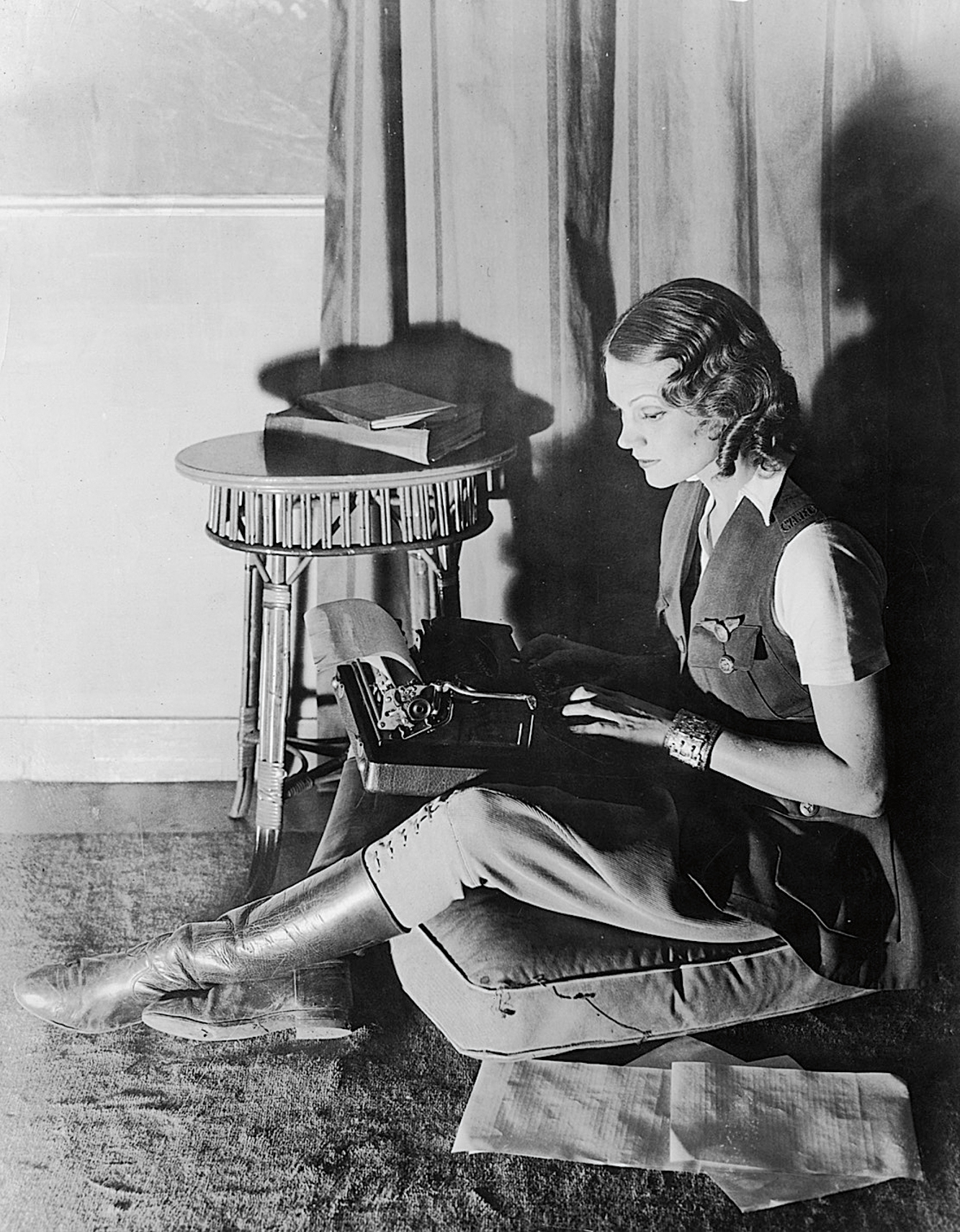The year was 1922, and the casualties of WWI were still fresh in everyone’s minds, contributing to a nothing more to lose attitude of the public at large. The women’s suffrage movement had just succeeded in 1920 of obtaining the right to vote, and if you were a woman, your job opportunities, aside from motherhood, were limited to the likes of being a secretary, social worker, librarian, nurse, or perhaps working in a textile factory. Sixteen-year old, multinational expat Idris Galcia Hall happened across a want ad on a scrap of the Nice, France, newspaper found tucked into a romantic novelette at the convent school she attended. Or so the story goes. It read Beauty, Brains, and Breeches—World Tour Offer for Lucky Young Woman…

Idris had grown up reading her father’s boyhood books, and though Herbert Hall was killed in action at Ypres in 1917 when a British Reservist, this legacy managed to inspire in her the beginnings of a proper adventurer. From her unpublished memoirs, “Imagination blended rash dreams with extravagant fantasies of daring-do.” With thoughts of exotic locales and “the ravishing thrill” stoking her imagination, Idris hightailed it to the theater where the potential employer was presenting, the dashing Captain “Cap” Walter Wanderwell and his Wanderwell Expedition (WE). These film lectures were the project’s lifeblood; funds were raised from the performances to finance the journey. The young woman applied in person after the show when she met Cap and persuaded him to take her on as secretary, a job which included a great many tasks: driver, translator, actress, photographer, filmmaker, seamstress, cook, mechanic, editor, and so forth. She then had to gain her mother’s permission, which was just barely managed. The account in Call to Adventure, our subject’s autobiography written in 1939, maintains that Idris’ mother appointed Cap as her guardian and insisted that she not use the family name. Thus, Aloha Wanderwell was born, and Idris, the teenage schoolgirl, laid to rest. Richard Diamond, Aloha’s grandson, contends that Aloha’s mother’s only request was that a chaperone, sister Meg (aka Miki) come along for the ride, though it is unclear as to how much of the journey she was actually on.
The Million Dollar Wager or Wanderwell Endurance Race, as Cap first called it, began in Detroit, Michigan, where he met with Henry Ford to discuss the project and gained the motor company’s support, along with that of Shell, Dunlop Tires, and Remington, to name a few. (In 1929, Henry Ford obtained Aloha’s car #2 and had it on display in his museum.) Cap set out from the States with a crew of four, driving Model Ts which had been converted to speedsters by the use of a duralim body on a touring car chassis with metal distal tractor wheels and other modifications. They were the perfect vehicles for the job: lightweight, able to be raised by their occupants, with good clearance, and simple to repair with a worldwide parts network. (Later on, Aloha dubbed them “wee iron maidens” and continued to drive Fords throughout her life.) The cars were numbered race car style and decorated with auto badges, acquired as the journey progressed, to garner attention.
It was indeed a race, as fly-by-night explorers were breaking out of the woodwork every day. As the planet began to shrink, becoming more accessible by both automobile and airplane, there was a deliberate rush to seek the places in the corners of the globe that were still shrouded in mystery.
A Polish national, Cap (Valerian Johannes Piecynski) was a member of the Volunteers of America and the World International Police; aside from promoting these organizations, he followed the League of Nations’ agenda of disarmament and peace, ideas presumably well represented in the WE’s lecture presentations. Richard referred to them as “goodwill ambassadors, with a yearning to shoot the wonders of the world and to go where no Westerner had ever been.”
Cap had already been to England before picking up Aloha in France, and as they started out, the idea became to have her be the first female to “girdle the globe.” Aloha was up for the task and always drove her own car, #2. For the sake of continuity and to promote the cause, she also became the primary face of the WE, and it is her image that is seen more than any other in the 35mm footage and photographs the group produced.
And what an image it was. Far from being the girl next door, Aloha had a statuesque beauty: the head atop her six-foot, one-inch frame held a crown of wavy golden locks, luminous, large gray-blue eyes, dimples, and red Cupid’s bow lips. Her traveling attire included breeches, a white shirt (sometimes referenced as her father’s tunic), leather jerkin and uniform cap, and a leather flying helmet which was pulled into service when needed. On film, she has a commanding presence that comes across as playful at times, yet always alert, intently tuned into her surroundings and interactions. With the looks of a movie star, it is surprising to find that Aloha had Victorian sensibilities rather than those of her flapper contemporaries. In Call to Adventure, Aloha declared how “jazz and jitter leave me cold,” and how she had no time for cigarettes or wine.
Fueled by the spirits of recklessness and bravado that only youth can conjure, Aloha took up with the expedition. After a promising first year in Italy, France, Spain, Portugal, Switzerland, Holland, Germany, and Poland, her ambition suffered a blow when the caravan became snowbound in the Carpathian Mountains. Suffering from the extreme conditions, exhaustion, and fallout after a disagreement with Cap, Aloha pulled out and went home in December of 1923.
Aloha’s journal excerpt, December 10, 1923 [Car] #3’s radiator froze, #2 pulled up behind and stalled. Drifting white flakes settled as we five worked like demons. Nothing in the engines moved, and the cars rapidly became white mounds in the vast white landscape. We were snowbound in the Carpathians!
The now 17-year-old Aloha realized her misstep, and with the plucky determination that she became known for, wired Cap to ask to rejoin the party in Egypt. Though her role may have been recognized as being crucial to the expedition’s success, there’s a good chance that Cap was already in love with Aloha as forgiveness came quickly. Cap was reportedly difficult at times, a hard worker who expected no less of his compatriots, and certainly required that his team members be capable of taking care of themselves. She was instructed to get to Egypt of her own accord.
Aloha had just enough money to book a fourth-class ticket in steerage from Marseilles to Egypt in March of 1924. After arriving at the shipping office, she was met by a clerk who told her that no white woman could travel in this manner on any ship, especially a young woman. The adamant Aloha argued her way onto the boat, only to find upon boarding that steerage was also to be occupied by 250 French Colonial troops with whom she would be bunking. Not to be swayed, she kept her chin up, but was accosted in the middle of the night by a naked man demanding affection—after fending him off with blows and screams, a sergeant finally heard the scuffle and took the attacker away in irons; the rest of the trip ensued without further trauma.
While the outcome of this episode seemed to be at least partially determined by a bit of luck, Richard described to me how Aloha had a knack for escaping trouble. “She was courageous, a leader, but she never got stuck in a problem. She knew how to lower her head and eyes and move forward or back, depending on the situation. She had an aura, a presence—she was real. It’s what kept her alive all around the world.” This skill set served her well in the years to come.
After eventually reconnecting with Cap, the ensemble traveled to the Valley of the Kings, setting up camp on the back of the Sphinx as Howard Carter worked fervently on excavating Tutankhamun’s tomb a mere 100 miles away. The affair was seen as “great sport” by Aloha. A local newspaper, read by the hazy light of Cairo, indicated that a group of five American flyers from the US Army Air Service was attempting to circumnavigate the world for the first time to prove the safety of the modern airplane and were making a stop in Calcutta, India. Aloha insisted to Cap that although it was 3,000 miles out of their way, they should go to Calcutta to meet them. After all, she was to be the first woman to drive around the world and a rendezvous only seemed fitting.
The timing was tight as the entourage hurried their way to India. Along the way, Aloha managed the unthinkable and snuck into Mecca disguised as a man, much to Cap’s chagrin. Her stunt put the whole ven- ture as well as their lives at risk, causing Cap to ask, “Do you ever think of anyone but yourself?” Aloha was decidedly unapologetic, and her “bumptiousness” was buoyed by ignorance, the “wonderful asset for extreme youth.” Her independent spirit and sense of living in the moment never wavered to the end.
Then came Yemen and Bombay where the troupe received a first-rate reception before motoring into central India and the magnificent Taj Mahal. A clean bed was always a welcome respite from the constant bouts with bedbugs. Fine company in the way of headmen, dignitaries, and royalty made up for the long distances covered in solitude. Her firm grip, which Aloha surmised came from the constant grasping of the steering wheel, was put to good use on many an occasion.
June 1924, Bombay
I was off to maelstrom Bombay—my first time alone at the wheel ever! In and out between bullock carts, missing buffalo by the skin of my teeth. Alexandra was by then dotted with staggered pyramids of Hankow’s cargo—silver bullion! At Red-Gate dock exit, a dozen dark hands rose to halt me. Sapristi! What now?! I put a stern glare, saluted, and drove out.
June 1924, Nasik Village
Fourth day, we were unable to cross a broad river. Without a word of English, news spread that we needed help. Eager to earn a few annas, peasants hitched three pairs of oxen to #2.
In Gwalior, a maharajah became entranced with Aloha, first gifting her one of his elephants, delivered to her hotel door. When the gesture was politely refused for reasons of practicality, he settled on giving her his monkey, which Aloha called Chango. Chango was to become her favorite, near-constant traveling companion, chattering away during the long miles, overseeing the many tribulations and successes of the venture.
Aloha drove the infamous Khyber Pass, and remembered a signpost devoid of writing, instead picturing “an automobile on one wing and a camel on the other…[which] made everything clear as to traffic rules.” At 2,000 feet, the group stopped to cool the engines and heard an unusual melody dancing on the wind: tribesmen leading a 200-count camel train, their chanting interrupted only by the “thud of pack-camel pads and the shrill cries of the drivers.” After completing the pass, the Afghanistan frontier was found blocked with barbed wire and a sign forbidding entry without the proper permits. A soldier explained there was no way that a white woman would be allowed to traverse the road, and so reentered a recurrent theme. Aloha had to settle with the fact that she had finished the Khyber.
Benares and Bengal proved particularly challenging, punctuated by exhilarating experiences such as witnessing Mahatma Gandhi speaking to the masses and visiting temples in Benares thought particularly sacred since locals believed it to be “the first land to rise from the waters of Creation.” In juxtaposition, Aloha recalled the bubonic plague warnings in Benares, where she saw “a black rat, the size of a small cat, running in the gutter.”
June 1924, Benares
Weaving our way through town, several people stopped us to warn about the bubonic plague. They recognized our cars, our probable ignorance.“If you see a crew of Untouchables whitewashing a ring encircling a dead body on the street, that is bubonic. Good luck.” Below us, the cremation terrace, greasy blue smoke rising from funeral pyres. Other shrouded corpses lashed to pole stretchers lying ready on ghats. The stench was foul.
June 1924, Bengal
Final forty-eight hours of driving, no sleep, no dry rags. I ached with wracking shivers; fingers were seized to the wood steering. Bengal at last! Dense jungle, improbably green timber bamboo, its heavy foliage bridging the sky.
Cap ahead, stopped in the bamboo, came back to parley, “Calcutta tonight—can you hang on? Only about sixty miles, I figure.” The shakes were so severe I couldn’t open my mouth. With teeth clenched I shook my head up-down. We pulled out.
Finally, Calcutta, and just in time. Newspapers crowed the success of the motorized age and the intersection of the Yanks who were flying around the world with those that were dedicated to the task by land. After driving in 110- to 120- degree temperatures through India, Aloha was quoted in the Los Angeles Times much later in life that afterward, she “couldn’t get out of bed for a night and a day.” In the meantime, two of the Flyers’ planes landed and were displayed next to the WE cars. Aloha awoke and captured the historic meeting on film after greeting one of the handsome young men in “grease-sodden overalls” who was plainly pleased to encounter such a bold and beautiful girl in this unexpected place and time.
Prior to departing by ship for Penang, Malaysia, India held one last unpleasant surprise. An insect bite on Aloha’s foot, acquired at a masquerade ball the night before the expedition was to sail, nearly cost Aloha her leg. A doctor on board the boat the next day took a look at the bite, dabbed a little salve on it, and advised her not to worry. As she limped off the boat after docking in Penang, the center of the sore was an angry green. She stayed with a local family who nursed her back to health after the wound was lanced with a razor blade. Not to be kept down for long, and with China calling, Aloha kept moving.
Aloha spoke fondly of Cambodia’s Angkor Thom and Angkor Wat and the stalwart stone bridges they trundled over that had withstood hundreds of years of abuse and still stood strong. Despite the “angry poisonous reptiles,” her desire was to linger longer, but their pace was anything but leisurely. It’s true that Aloha’s passion for adventure kept her in motion; the knowledge that something new was always waiting for her over the next hill. The world and its secrets were always at the ready.
Civil wars were rampant in China, roads were often blocked, and the dangers omnipresent. Aloha went so far as to visit a temple in Peiping to pay homage to a marble god of war because she “thought I ought to.” The goal was to reach the Manchu capital of Mukden en route to Vladivostok.
August 1924, Shan Hai Kwan
We put in at Shan Hai Kwan to be bathed, deloused, and fed. U.S. Marines were very kind. Our main anxiety was how to avoid that week’s bloody war zone. Corpses lay half-covered, some bolt upright in ditches, hideous flyblown limbs scattered by explosions. Sometimes we heard the boom of artillery.
The expedition was delayed over and over by soldiers demanding to know what right the foreigners had to be traversing their land. They were routinely chased by troopers with guns but always managed to elude capture. Until that is, soldiers in a small mud hut village planted rusty nails on the path to thwart their progress. The man in charge accused the group of being spies and locked Aloha and another woman named Olga into a squalid mud hut racked with filth and a foul odor while he questioned the others. Cap made no progress in talking their way out of the situation, and it appeared as if the fate of the organization lay in Aloha’s hands. As she approached the officer with photographs and newspaper clippings in hand, he grabbed her wrists and began to shake violently. He then reeled and fell, presumably dead. As the other soldiers dispersed in confusion, Aloha and company raced for the cars, spewing mud I’m sure, as they rode to temporary safety.
Temporary, as they still had to drive through the combat zone to reach Mukden, amidst the alarming rattle of machine-gun fire and decomposing bodies strewn on the ground. After making it through no-man’sland, uninvited escorts showed up and politely insisted on taking them to a European style house, where they were introduced to a man that turned out to be General F. A. “One Arm” Sutton. After learning of the group’s exploits, he promised his protection for as long as they were in the area. By this time, the Wanderwell Expedition had grown to five automobiles, two motorcycles, and one bicycle with over 100 active members en route on five continents, and their accomplishments were many.
Aloha celebrated her 18th birthday in Vladivostok in October, as well as the fact that she was in her 39th country since taking up with Cap. There were constant comings and going in her hotel room by various persons, but when three Soviet military men burst in, one of them barking commands while pointing to his watch as Aloha was forcefully removed from her room, uncertainty entered Aloha’s mind. With an only rudimentary grasp of the Russian language at the time, she discerned that the orders were for her to follow them and report to the parade ground immediately. This was cause for concern since this is where executions took place. As Aloha wondered if she was to be court-martialed and shot, the soldiers led her to a presentation room at the hotel where two special auto badges from the Russian Auto Workers’ Union were displayed on a white marble altar. The big smiles on the soldiers’ faces now revealed that they were fans. In the next few moments, she realized she was being complimented for being the first woman to drive an automobile to Siberia. Instead of death, at the parade ground, Aloha received the honorary title of colonel in a formal ceremony amidst a regiment of soldiers. This title was to get the expedition into trouble later on in Africa when Rhodesian authorities refused to give the WE, clearly “communist propagandists,” entry into the country.
Japan was the next major stop, where the expedition was mortified to learn that a competing theater in Tokyo had arranged to have a man publicly commit hari-kari while the WE presented at another venue, all in the spirit of competition. According to Richard, the Japanese loved Aloha. The lectures were well attended and standing room only, and they even received formal recognition from the Emperor of Japan by way of a smile and a bow. In Kyoto, the center of Japan’s film industry, they were permitted the use of a studio for their film work, a blessing since preserving the nitrate film on the route was an arduous task in and of itself. By now, Aloha was a big part of the editing process and screenwriting, a budding cinematographer in her own right.
The company’s sights were now turned to America, the place they all considered home. The Wanderwells always flew the flags of whatever country they were traveling in, and despite Old Glory flapping in the breeze on the back of every vehicle, they arrived to a lackluster reception back in the States. Lackluster is putting it kindly. Disbelief and skepticism were the prevailing attitudes, and after being welcomed for the most part all over the rest of the world, Aloha observed that “We seemed at the moment to be very much prophets in our own country.” It is also ironic to note that Aloha found the manicured streets of the US to be the hardest to navigate, compared to all of the other roads she had traveled.
By January of 1925, Cap and Aloha were in San Francisco and would later move on to Los Angeles to continue their film work. In the course of a few months, Aloha’s Sam Browne belt got her into trouble when she was arrested for impersonating a military officer by wearing a uniform (not a US uniform, rather the company one designed by Cap, inspired by those of the Boy Scouts) and fined. Another account relayed that Aloha was arrested yet again while giving a presentation in Pasadena with the charge of working underage. Though she was 18 at the time, Richard joked that Aloha put a different birthdate on every important document—sometimes 1906, other times 1908; this may have lent confusion as to her actual age. Richard also shared that she always put 5 feet 9 inches down instead of her true height.
In April 1925, Cap returned from Florida where he had bought property in Miami for their future home. One story has the Wanderwells attempting to cross the California border and being threatened by authorities with the Mann Act since Aloha was not yet 21 years of age, prompting a speedy proposal from Cap. Aloha recounted that Cap professed that he had always loved her, and had proposed immediately upon his return from Florida. Perhaps both stories hold true; they were married posthaste in Riverside, California.
A whirlwind lecture tour of the States ensued, and car #6 was added to the fleet. Cap created a club for fans, instructing those that could not join the WE on the road to bring their cars, add the company’s insignias, and spread the message of pacifism. Car jamborees were planned in Miami, and membership dues collected.
Daughter Valri was born prematurely to the couple in December of 1925, and by January 31, 1926, the pair were off to Havana, Cuba, en route to Africa. In December of 1926, the family arrived in Cape Town, South Africa, and Aloha was pregnant again with Nile (Richard’s father) who was born in Durban in April of 1927. Nile was barely three weeks old when Aloha sent the children to her mother in Adelaide, Australia, before hitting the road once again. Aloha was just 21 years old at this point, and her call to adventure unsatiated. Still, there has been criticism that Aloha abandoned her children to chase wild, remote lands. The fact that she was a woman is what seemed to startle most naysayers; men left their children behind all the time, including Cap. Aloha was perplexed at how to deal with the situation and the job of caring for the children primarily fell to her mother, Margaret Hall. Aloha had long considered herself the man of the family after her father passed, so this likely seemed a logical choice.
The Guinness Book of World Records officially recognized Aloha as the first woman to travel around the world and after four years of research, they listed the dates for this feat as 1922 to 1927. According to Aloha, it was 43 countries, four continents, and 380,000 miles, with the initial trek concluding in 1929 (after the race officially ended in 1927 back in Detroit), documented in the Wanderwell’s film Car and Camera Round the World, later shortened to Car and Camera. But this was just the beginning.
The Africa segment began after Aloha’s children were born, and sister Miki joined up, driving car #3. When the WE’s hired projectionist was shot in South Africa, leaving them without a means of income, the group started a jazz orchestra in Jo’burg, and Miki and Aloha went and dug for diamonds. The girls had reportedly amassed a small fortune when they forgot about the stones in their pockets as they laundered their shirts in the stream. Alas, easy come, easy go.
Some of the other trials in Africa included an elephant stampede, where abandoned village huts were set fire to in an attempt to steer the elephants in another direction; unfortunately, the snakes that poured out of the empty dwellings presented another problem altogether. Malaria also hit the WE hard, and Aloha very nearly died. The Cape Town to Cairo route was attempted, but not completed, partly because Rhodesia would not let the “communist” company in. Water was also hard to come by, and the risks and suffering due to the lack thereof became so great that it was taken wherever it could be found. Aloha describes lapping “slimy, putridly saline liquid” as their lives depended on it.
In the early 1930s, Aloha became an aviatrix. After mastering the art of flying, she devised a plan to fly around the world with a car caravan below her, while spreading the message of peace and advocating for women’s rights. The plan was to distribute a petition that would be signed by women only. Her plane was the Gypsy Moth, designed so that the wings could be folded back to allow it on a steamship. After a sixmonth trial in the US, it was decided that the cost was too exorbitant and therefore unrealistic.
Aloha’s flying skills were put to the test when a rescue mission was planned in the Amazon to search for the lost British explorer Colonel Percival Harrison Fawcett. Into Mato Grosso and uncharted territory they flew, where Aloha completed another major achievement as the first woman to ever fly into the region. She ran out of gas while trying to find a suitable place to land—there were none. The plane crashed in the domain of the Bororo, and Aloha spent six weeks with the tribe while Cap went by boat in search of parts and gas. There is a fascinating Wanderwell film titled The River of Death that chronicles their experiences. By the end of her stay, Aloha, always one to pick up languages quickly (she was fluent in 11), had learned Bororo. The footage shows her participating in local customs and dances as she probes for information on the lost explorer. Aloha determined that Fawcett was dead, and when Cap returned with the supplies, they successfully repaired the plane and flew their way out of the Amazon.
Back in Long Beach in December of 1932, Cap was unexpectedly shot and killed by an unknown assailant while aboard his 120-foot schooner. The mystery was never solved, although there were plenty of suspects.
In 1933, Aloha met Walter Baker in Laramie, Wyoming, while on tour, and the pair married later that year in Louisiana. In 1936, Aloha and Walter began another, more intermittent expedition, this time driving Model As, traveling to Aloha’s favorite spots from her earlier journeys; Egypt and India were particularly close to her heart. New countries were also explored including Thailand, Australia, and New Zealand. The couple wrapped up their travels in 1947.
Walter Baker became a successful developer in California and the two eventually settled on Lido Island in 1948 in a house that he built. Aloha continued her work as a cinematographer and anthropologist, presenting motion picture presentations and lectures at the Bowers Museum in Orange County, California, and at various clubs.
Other collaborative projects for the Bakers included a Technicolor film called Explorers of the Purple Sage which took place in Wyoming featuring the state’s wild horses. It was the only body of work to ever capture the famous palomino Desert Dust on film.
The last 10 years of Aloha’s life were spent organizing her collection and completing her memoirs. No mean feat to be sure. With the vehicles and gear that overlanders use today, it is almost inconceivable to think of the modest Model T and Model A Fords accomplishing the tasks they did for the Wanderwell Expedition. Not to mention the fortitude that was required by the drivers as they pushed into hazardous conditions without the modern conveniences we require, such as a heater, air conditioning, water filter, or winch. This account from Call to Adventure showcases the ingenuity employed in a tight spot in Africa: “I used crushed bananas in the differential,” said Eric Owen [a WE member], “that’s that smell. I had elephant oil and olive oil as lubricants, and they’re not too good for any car, even an auto like this.”
Richard has fond memories of Aloha’s last film lecture, given at the National History Museum of Los Angeles in 1986 for a gathering of 150 close friends and family. Dressed in her original costume, Aloha walked onto the stage as Car and Camera played for the last time. “She never missed a line,” Richard proudly professed. “She knew what it takes. When you met her, you never forgot her.” By the end of her life, the tally had reached 500,000 miles, 75 countries, and six continents. She was quoted as saying, “Somebody once said to me that you never really live unless you live dangerously, and while it may not be true of everybody, it certainly is true of me.” Aloha Wanderwell was the Queen of Adventure.


